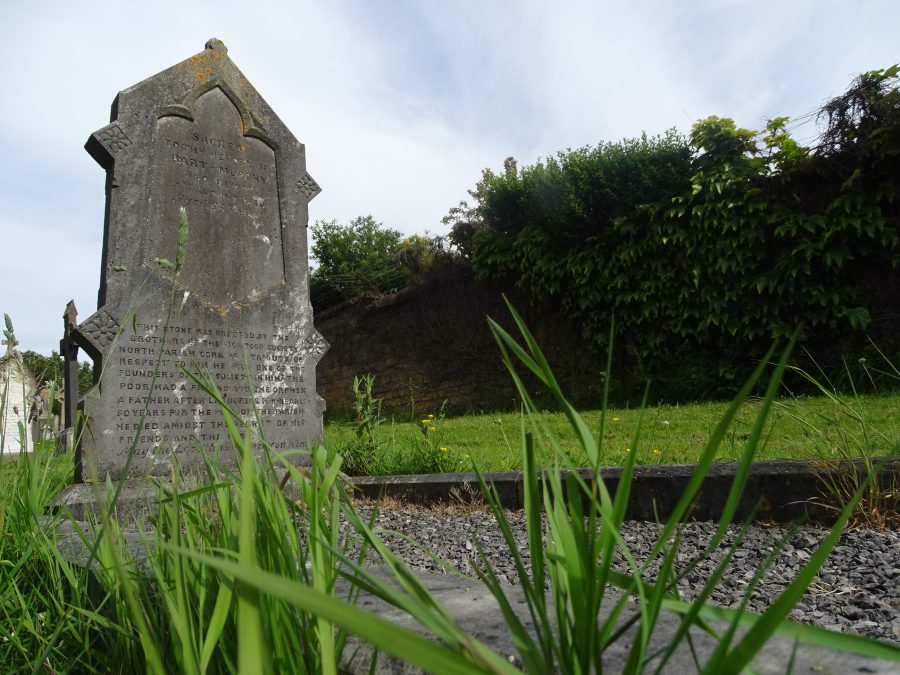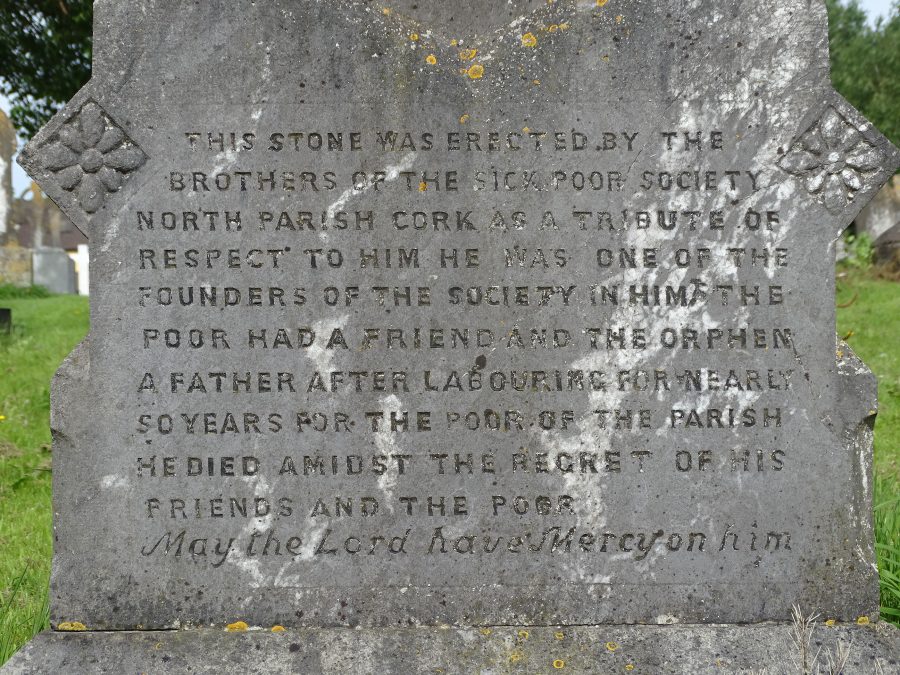
1052a. Gravestone of Bartholomew Murphy, founder member of Cork’s Sick Poor Society, at St Joseph’s Cemetery, Cork (picture: Kieran McCarthy).
Kieran’s Our City, Our Town Article,
Cork Independent, 11 June 2020
Remembering 1920: Sick Poor Society Celebrates 200 Years
One hundred years ago on 13 June 1920, to celebrate the centenary of Cork’s Sick Poor Society, Solemn High Mass was held at the North Cathedral at 12noon. Bishop Daniel Cohalan in his homily related some of the important work of the society. The Cork Examiner also provided a short history of the Society, some of which I detail below. In 2020 the Society celebrates its bicentenary.
Throughout the early nineteenth century narrow lanes were widespread in Cork’s suburbs. The various habitations varied from cabins to cellars. Reports on their terrible nature record the presence of large dunghills strewn across adjacent laneways. In the northern district were the most crowded and populous streets. Wretched houses, divided into separate tenements, accommodated a large number of people – upwards of four people in small rooms. Many families were on the verge of starvation and many were ashamed to ask for help. The North Chapel and the South Chapel provided for the religious and charitable needs of the impoverished population.
In the early months of the year 1820, Bartholomew Murphy and his friend, both working men of the Cathedral Parish, met on their way home from early Mass on Sunday morning. Their conversation turned to the poverty and sickness all round them. One family near him (three being sick) had no food of any sort. They decided that they would go around the locality and collect some aid for them. They were joined by a third man, who, hearing of their determination to do something for the poor, decided to accompany them on their mission of charity.
The collection was far more successful than they anticipated, and the result was they were able to assist, not one, but three families. They decided to repeat the collection on the following Sunday, being assisted by three more volunteers. Henceforth their work was carried out on Sunday after Sunday and always with many additional Volunteers coming forward to help. By 1822, the membership stood at twenty-six.
Bishop John Murphy asked that these men should band themselves into a society, which he named the Sick Poor Society. Rules were formed for its better government and management. Notwithstanding the name of the Society, the members were always known, as the Friendly Brothers. Early records of the Society record that in addition to monetary aid to families the members had very often to enlist the assistance of some kind neighbour, to look after the wants of those who were unable to do anything for themselves.
In the olden days some of the members did not possess finance themselves, and when financial trouble came their way, the Friendly Brothers were there to assist. An example is given on the death of a member’s wife in the year 1839 when his 28 fellow members subscribed monies for her funeral expenses.
In 1848 under the guidance of Bishop Delany, members formed a Rosary Society for the purpose of reciting the Rosary each night in the Cathedral, an activity, which continued for very many years.
During the Society’s existence the parish experienced many severe and trying visitations of sickness and want, notably those of the cholera, the Great Famine period of 1847, small pox in 1872, and last, but not least the trying visitations of influenza during 1918 and 1919, all of which taxed the members and their funds to the utmost.
The average membership of the Society from 1822 to 1920 varied from 35 to 40, and the Cork Examiner estimated that between 1820 and 1920 that upwards of £50,000 was raised. Many miles had to be walked to make up this sum in pennies, and very often half pennies.
Some of the older members devoted the greater part of their lives to the work of the Society. The Cork Examiner article of June 1920 mentions minute books that show that many old members laboured continuously for over fifty years. Founder member Bartholomew Murphy gave 52 years service before he passed away and was buried in St Joseph’s Cemetery. Some families were recording as having four generations involved. Very often, when the funds were exhausted and the weekly collections became unequal to the demands of all applicants, members came to the rescue with their own money.
Off-shoot branches were also established in the parishes of SS Peter and Paul and St Finbarr’s South Chapel respectively. The South Chapel Society was formed as a Confraternity under the patronage of Mary Immaculate on 8 December 1853 – one year before the Immaculate Conception was made an article of faith by Pope Pius IX. In 1866, the Cork Examiner that over 900 families or 3,168 individuals were provided with relief in the South Parish culminating in near 2,000 visits.
In 1863, the Cork Examiner describes the Sick Poor Society of the SS Peter and Paul’s Parish as one of the most active and efficient benevolent societies in Cork. A total of 1,054 sick and poor persons were visited and relief provided in one year alone and in one parish in the city alone, by members of the society.
In addition to Sick Poor work, the members took a leading part in many other parish functions, such as the distribution of the coal fund, and the successful working of the Bishop’s milk fund, which was distributed to mothers and children of the poor. The Penny Savings Bank of the North Cathedral parish was also practically managed by the members, with marked success together with many other social undertakings.
Happy bicentenary birthday to Cork’s oldest charity – the Sick Poor Society.
Kieran’s new book Witness to Murder, The Inquest of Tomás MacCurtain is now available to purchase online (co-authored with John O’Mahony 2020, Irish Examiner/ www.examiner.ie).
Captions:
1052a. Gravestone of Bartholomew Murphy, founder member of Cork’s Sick Poor Society, at St Joseph’s Cemetery, Cork (picture: Kieran McCarthy).
1052b. Inscription on gravestone of Bartholomew Murphy at St Joseph’s Cemetery (picture: Kieran McCarthy)

1052b. Inscription on gravestone of Bartholomew Murphy at St Joseph’s Cemetery (picture: Kieran McCarthy)